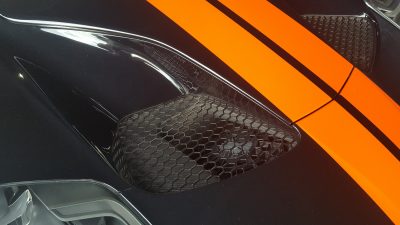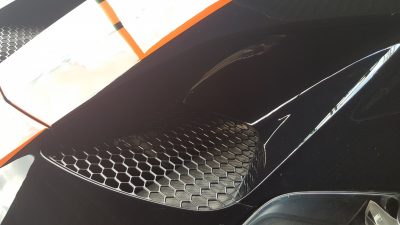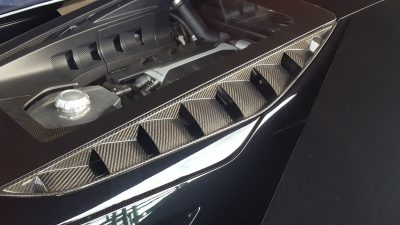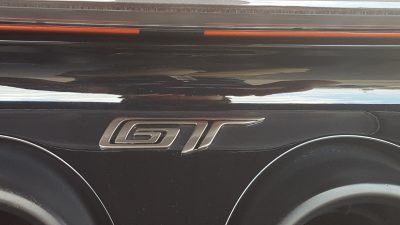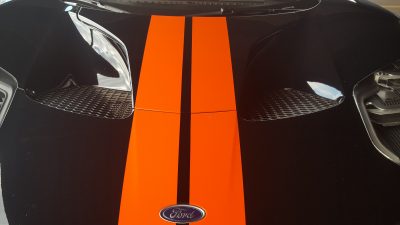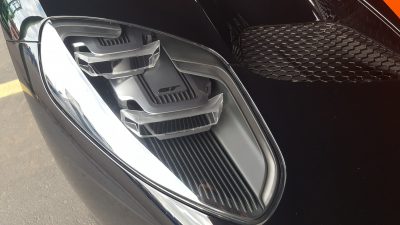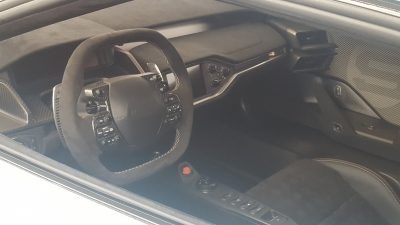When Ford first revealed the 2017 Ford GT at the North American International Auto Show, it was arguably one of the best kept secrets at the show that year. It was also the best kept secret at Ford, with only a scant few knowing of its meager origins until the very end of its development cycle. Since then, the GT has been a very potent marketing tool for the company, and it has proven to be a very compelling piece of eye candy for millions of enthusiasts around the world. We first had our taste of GT infused bliss when we had the chance to go for a thrilling hot lap ride around the Road America race circuit during the 2018 MAMA Spring Rally event in Elkhart Lake, Wisconsin. While this firmly established the GT’s track credentials, we still wondered what Ford’s newest hypercar would bring to a more road going environment. After a long wait, we finally had the opportunity to find out on our home turf at the 2019 Woodward Dream Cruise, and see if the GT is indeed a great all rounder or not.
Purposeful Styling Enhances Functionality:
When one first looks at the exterior styling of the Ford GT, their eyes are immediately drawn to just how sleek and stunning the car looks when viewed from multiple angles. While our tester was a 2017 model (2019 brings very minimal changes to the car) it certainly looks like nothing else on the road with the sleek bodywork drawing an enormous amount of stares, and an equal amount of praise which is something the typical Toyota Camry could never pull. Indeed, from the taut surfacing, lighting that looks like it was forcibly ripped out of The Jetsons, the elegantly crafted scoops, to the insane and visually dynamic flying buttresses that connect the cabin to the rear wheel arches, the Ford GT simply oozes coolness. But don’t let that fool you into thinking that the GT has gone for Fabio-esque good looks at the cost of functionality, every single inch has some form of inner purpose. For instance, the front bumper features a special intake that helps not only reduce drag, but also allows most of the cooled air to exit via the large and stylish hood vents. Meanwhile the side of the GT features special keel assemblies that help direct and channel air underneath the car. Even the buttresses are functional, with the units housing the two charge coolers needed to help cool the turbochargers down, with each side adorned with one. Finally the rear of the GT features an attractive set of ringed taillights, as well as the centrally mounted dual exhaust tips to help bring a formal exclamation point to the design.
When viewed against rivals like the McLaren 720S, Lamborghini Huracan, and even the Acura NSX that we recently reviewed, the GT is the decidedly more minimalist member of the super and hypercar ranks. But that’s not a bad thing considering that it has more of a race ready presence than all three of those cars, and it is also a subtle tribute to the original GT40 racer that immediately shook LeMans, and helped dethrone the proverbial master of that empire, Ferrari. While the car we drove featured a sinister shade of Shadow Black (versus the Liquid Blue hue Ford had on its display car,) it still looked very sharp, especially when paired with its contrasting orange racing stripe, and the optional gloss finish carbon fiber wheels.
A Cabin That Embraces Minimalism….At A Price:
With the exterior styling doing its best to stimulate visual overload, the cabin is a decidedly more restrained experience. With the GT essentially being a road legal race car, it has no problem reminding occupants of this fact of life in various ways. For example, the GT is a function oriented instrument, and as such pitches many of the electronic and luxury laden wiz bang gadgetry that has become a focal point in some of its peers. Instead, the simplistic layout only puts what you need in front of you, and while the cabin does look quite cheap at first glance. Spending extended time looking around at your surroundings does help you warm up to its charms. The supportive albeit basic seats don’t have any form of adjustment, but the driver does benefit from a tilt/telescoping wheel, as well as an adjustable pedal box, with the latter being a welcomed blessing for our long legs. Some of the controls of the GT also adopt a more basic motif, with the rotary type switches being more at home in a 15 year old Taurus, and the basic infotainment screen feeling like something straight out of 2010. Thankfully, the digital instrument cluster looks state of the art, and does an excellent job delivering information that drivers need the most when going through hot laps.
The wild exterior design also causes some dividends to be paid in terms of visibility. While the view out the windshield and side windows is decent for a vehicle in its bespoke segment, rear visibility is comically bad, with some caution being needed before undertaking lane changes. Luggage space is also minimal, with the GT offering a rather modestly sized frunk that will force occupants to pack accordingly when out and about on a weekend jaunt. This is less cargo space than a few of its rivals, but the amount of performance on hand here will easily make you forget about these quirks. This extends to the soundtrack from the twin-turbocharged V6 behind your head, which will allow you to not notice the average sounding four speaker stereo that is installed into the GT.
Lastly getting in and out of the GT is an acquired skill, with occupants being forced to sit on the fat side sill, and to essentially fall into the seats. Once that is done, then you can swing your legs in and nestle yourself into place. For comparison, the McLaren 570GT we tested several years ago offered slightly easier entry and ingress, but at the cost of ducking your head to avoid banging your cranium against its roofline. The seats themselves are as they appear, with the units being nothing more than lightly adorned carbon shells. But for such a basic throne, the seats are reasonably cozy places to spend time in, and do a good job of keeping occupants in place during bouts of spirited driving.
Earth Shattering Performance:
The real headliner here is what lurks under the GT’s bodywork, with all models being powered by a 3.5 liter twin-turbocharged V6. Like King Ghidorah breaking through his icy tomb in the recently released movie Godzilla King of the Monsters the 647 horsepower on hand bursts forth like a wave of power once the noticeable turbo lag goes away. The addition of a V6 to this iconic nameplate is arguably the most controversial aspect of the car, especially considering that its predecessor had a mid-mounted 5.4 liter supercharged V8. But that old block was heavy and decidedly less generous with its fuel economy, and once you look at the inner reasons why the V6 was added, it all begins to make sense. For instance, the V6 is shoved up against the carbon tub’s bulkhead, and the accompanying turbochargers and intercoolers all combine to actually take up less space than a bigger V8 would. Also, some of the aerodynamic enhancements would not have worked in conjunction with the V8 (Newtons third law in bold play here.)
Our tester was constrained to Woodward Avenue during our brief time with it, which limited acceleration bursts to free moments when Johnny Law was conveniently not present. However, we were later allowed to accompany the GT on its trip to the Mustang Alley display in Ferndale, where inconvenient Michigan construction detours forced the GT to do some brief freeway work. Here, we got to experience the full octave range of the engine’s soundtrack, and even from the passenger seat, the primal nature of its insane acceleration was enhanced and even magnified. A seven speed dual clutch automatic channels all of the engine’s grunt to the rear wheels, and we appreciated just how lighting quick and precise this gearbox is especially in higher speed driving.
When viewed against some of its rivals, the GT’s engine is roughly top of the pack, with the V6 having noticeably better responses than the 3.8 liter twin-turbocharged V8 in select McLarens, but it does lose out slightly to the NSX, which uses its electrification technology to help the engine be a bit swifter when it comes to the act of acceleration. Handling in the GT is also very track focused, and that includes having a stiff suspension that reminds you where the car prefers to be when it goes over road imperfections or railroad crossings. Find yourself on smoother tarmac, and the car rewards you with virtually no bodyroll, and the steering having a very predictable and accurate feel to it.
Value Quotient:
Unlike other cars we have rated in this particular category, the Ford GT brings some unique conditions in regards to purchasing one. For instance, while many supercar and hypercar entries tend to have higher production numbers, Ford is limiting purchases to people that it deems fit to own one, and as a result, makes potential buyers go through a rigorous screening process. Make the cut, and you will be greeted with a $500,000 base MSRP which caused the GT to leapfrog two Rolls Royce offerings that we recently tested (reviews pending) for the title of priciest car to ever be tested by our Michigan office. Our lightly optioned 2017 tester brought several goodies to the fray including gloss black carbon fiber wheels, the “Launch Control” contrast color scheme (AKA orange,) as well as other minor extras. These helped the price jump past this figure, with our tester tallying just over $510,000.
This is more than the McLaren 675LT, but the GT does have superior aerodynamics, and a more responsive engine to help counter the McLaren’s challenge. Ford is also heavily touting the GT’s exclusivity, with the company only producing about 1,350 for its four year production run via a partnership with the Canadian firm Multimatic. This figure was initially 1,000, but Ford was forced to expand this number slightly after strong customer demand as well as several hiccups that occurred in the GT’s launch period. Buyers thinking that the GT will depreciate in price when it enters the used market will be in for a big surprise, with the car displaying an impressive degree of residual value that has only increased in time. With the two year no-sale clause expiring for some of the early GTs ordered, second-hand prices have surpassed $1 million dollars, which has made the car into one of the best initial long term investments we have seen in the collector car world.
With the recently unveiled track only GT Mk II serving as the bold swan song for the GT’s imminent departure, enthusiasts can take heart knowing that the GT will retire not with a whimper, but a rather big bang that will help it cement a strong legacy in the hearts of enthusiasts worldwide. We look forward to seeing how some of the GTs engineering innovations and solutions will eventually trickle down to other Ford models, especially as the company begins a bold shift to expanding its SUV and pickup truck lineup.

Carl Malek has been an automotive journalist for over 10 years. First starting out as a freelance photographer before making the transition to writing during college, his work has appeared on numerous automotive forums as well as websites such as Autoshopper.com.
Carl is also a big fan of British vehicles with the bulk of his devotion going to the Morgan Motor Company as well as offerings from Lotus, MG, and Caterham. When he is not writing about automobiles, Carl enjoys spending time with his family and friends in the Metro Detroit area, as well as spending time with his adorable pets.





